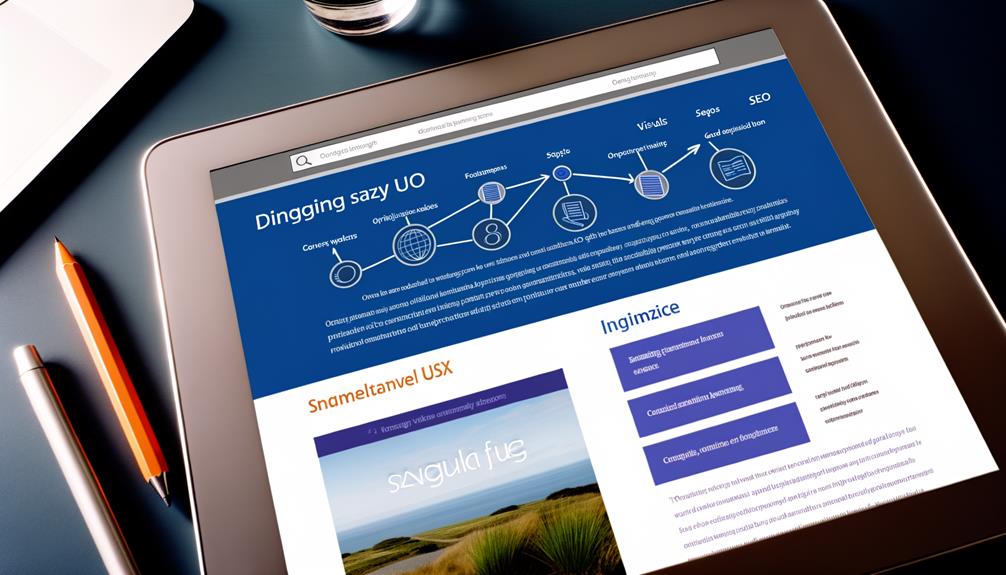As we navigate the ever-evolving landscape of digital experiences, it's imperative to recognize the pivotal role of UX strategy in shaping the way users interact with brands online.
UX strategy isn't just about aesthetics; it's a strategic approach that intertwines user needs, business objectives, and technological capabilities to create meaningful and impactful interactions.
The impact of UX strategy extends far beyond the surface, and understanding its intricacies is essential for businesses looking to stay ahead in the digital realm.
Join us as we uncover the critical components, real-world examples, and transformative power of UX strategy, shedding light on its profound influence on user satisfaction, brand perception, and business growth.
Understanding UX Strategy

Understanding UX Strategy is crucial for creating a user-centric approach to design and technology. It identifies features that impact user experience, determines improvement areas, and aligns business mission, IT capabilities, and user needs.
A strong UX strategy positively impacts customer satisfaction, brand perception, and ultimately leads to increased sales and customer loyalty. Examples from industry leaders like Apple, Amazon, and Spotify showcase the power of a well-executed UX strategy.
To improve UX strategy, assess current conditions, identify specific objectives, map out the journey, conduct user testing, and continuously iterate and optimize.
By focusing on solving for UX strategy, streamlining site actions, and boosting overall engagement, companies can achieve liberation from user frustrations and boost ROI.
Understanding the importance of UX in SEO is also crucial for maximizing the impact of a comprehensive UX strategy.
Components of a Strong UX Strategy
A strong UX strategy incorporates a long-term vision, innovative approaches, customer research, design excellence, and collaborative efforts to ensure optimal user experiences.
By having a clear vision, we align our efforts towards a common goal.
Embracing innovation allows us to stay ahead of the curve and continuously improve.
Customer research provides crucial insights to address pain points and meet user needs effectively.
Design excellence ensures visually appealing and valuable products.
Collaboration with experts fosters creativity and expertise.
A robust UX strategy is imperative for liberation in creating user-centric, value-driven experiences.
It empowers us to prioritize user satisfaction and drive business success.
Let's champion a strong UX strategy to liberate users from frustration and elevate their digital experiences.
Significance of UX Strategy

The significance of UX strategy can't be overstated in today's digital landscape, as it directly impacts user satisfaction, business success, and overall brand perception. A well-crafted UX strategy is crucial for creating meaningful and impactful user experiences that not only meet but exceed user expectations.
It serves as a catalyst for driving customer loyalty, increasing conversion rates, and fostering a positive brand image. By prioritizing the needs and desires of users, an effective UX strategy empowers businesses to differentiate themselves in a competitive market, ultimately leading to sustainable growth and success.
In essence, the significance of UX strategy lies in its ability to revolutionize the way businesses connect with their audience, driving meaningful interactions and long-term relationships.
Impactful UX Strategy Examples
The significance of UX strategy is underscored by real-world examples that showcase its transformative impact on user experiences and business success.
Apple's intuitive and seamless user experience, Amazon's personalized recommendations and easy checkout process, and Airbnb's user-friendly interface are just a few examples.
Spotify's personalized playlists, Google's simple search experience, and LinkedIn's onboarding process also demonstrate the power of effective UX strategy.
These examples highlight the importance of prioritizing user needs and creating intuitive, personalized experiences. By focusing on improving UX strategy, companies can drive customer satisfaction, loyalty, and ultimately, business growth.
These examples serve as a testament to the tangible benefits of investing in a robust UX strategy for long-term success.
Enhancing UX Strategy

Enhancing our UX strategy requires a comprehensive assessment of current user experiences and a strategic plan for iterative improvements.
- Embrace change: Let's challenge the status quo and fearlessly innovate for a better user experience.
- Empower creativity: Let's unleash our creative potential to design captivating and user-centric interfaces.
- Elevate collaboration: Let's unite diverse perspectives and expertise to craft seamless and inclusive experiences.
Solving Challenges in UX Strategy
To address the challenges in UX strategy, we must proactively identify and tackle potential roadblocks to ensure a seamless user experience. By continuously evaluating the current state of the UX and implementing step-by-step solutions, we can streamline site actions and reduce user frustrations.
Our focus is on simplifying and optimizing user interactions to boost overall engagement and ROI. We need to identify pain points and make necessary changes to enhance the user experience. This approach won't only improve user satisfaction and retention but also drive the desired user actions.
By understanding the correlation between user experience and search engine optimization, we can create high-quality, relevant content that meets user needs and improves SEO rankings.
Our commitment to solving challenges in UX strategy will result in a significant positive impact on the overall digital experience.
UX Strategy's Role in SEO

Analyzing user engagement metrics, such as bounce rate and time on page, is crucial for understanding the correlation between UX strategy and SEO.
User-Centered Design: Prioritizing user needs and preferences in website design fosters a positive user experience and boosts SEO performance.
Mobile Optimization: Ensuring seamless user experience across various devices not only satisfies users but also aligns with search engine algorithms, enhancing SEO rankings.
Content Relevance: Delivering high-quality, relevant content that resonates with users not only engages the audience but also signals to search engines the value of the website, positively impacting SEO.
Frequently Asked Questions
How Can UX Strategy Be Integrated With Project Management Practices for Better Results?
We integrate UX strategy with project management practices for better results by:
- Aligning project goals with user needs
- Ensuring a user-centric approach in all project phases
- Prioritizing UX improvements within project timelines
We collaborate closely with UX designers and project managers, conduct regular user testing, and iterate on UX strategies based on feedback.
This approach fosters user satisfaction, increases engagement, and drives successful project outcomes.
What Are Some Effective Ways to Measure the Success of a UX Strategy Implementation?
Measuring the success of a UX strategy implementation involves tracking overall traffic data, social media volumes, email signups, consumer sentiment, and conversion rates.
We regularly assess current conditions, implement step-by-step solutions, streamline site actions, reduce user frustrations, and boost overall engagement and ROI.
Understanding the correlation between user experience and search engine optimization, we focus on mobile-friendliness, page load speed, user engagement metrics, and user-focused content to ensure the success of our UX strategy implementation.
How Does a Company Ensure That Its UX Strategy Aligns With Its Overall Business Goals and Objectives?
We ensure our UX strategy aligns with our overall business goals and objectives by closely integrating UX decisions with our company's mission and key performance indicators. This ensures that every UX improvement directly contributes to our business success.
We collaborate across departments to align our UX strategy with our company's long-term vision and customer needs. Our iterative approach allows us to adapt our UX strategy to meet changing business goals and user expectations.
What Are Some Common Pitfalls to Avoid When Developing and Implementing a UX Strategy?
When developing a UX strategy, common pitfalls to avoid include:
- Overlooking user research.
- Neglecting user feedback.
- Failing to align UX goals with overall business objectives.
To prevent these pitfalls, it's crucial to:
- Prioritize specific UX objectives.
- Conduct thorough user testing.
- Continuously iterate and optimize the strategy based on feedback and data analysis.
How Can Companies Effectively Communicate the Value of UX Strategy to Stakeholders and Gain Their Support and Investment?
We can effectively communicate the value of UX strategy to stakeholders by showcasing its direct impact on customer satisfaction, brand perception, and business success.
We'll emphasize how a strong UX strategy leads to increased sales, customer loyalty, and company-wide alignment.
We'll use clear metrics such as improved conversion rates and customer feedback to demonstrate the tangible benefits of investing in UX.
This approach ensures stakeholders understand the undeniable value of UX strategy and are motivated to support and invest in it.
Conclusion
In conclusion, UX strategy is the cornerstone of successful digital experiences. It drives customer satisfaction, brand growth, and business success. By understanding its components, significance, and impact, we can enhance our strategies to better meet user needs and exceed business objectives.
Through collaboration and problem-solving, we can overcome challenges and redefine the digital landscape. Let's continue to prioritize UX strategy, leveraging its transformative power to shape the future of user-centric design and brand innovation.






